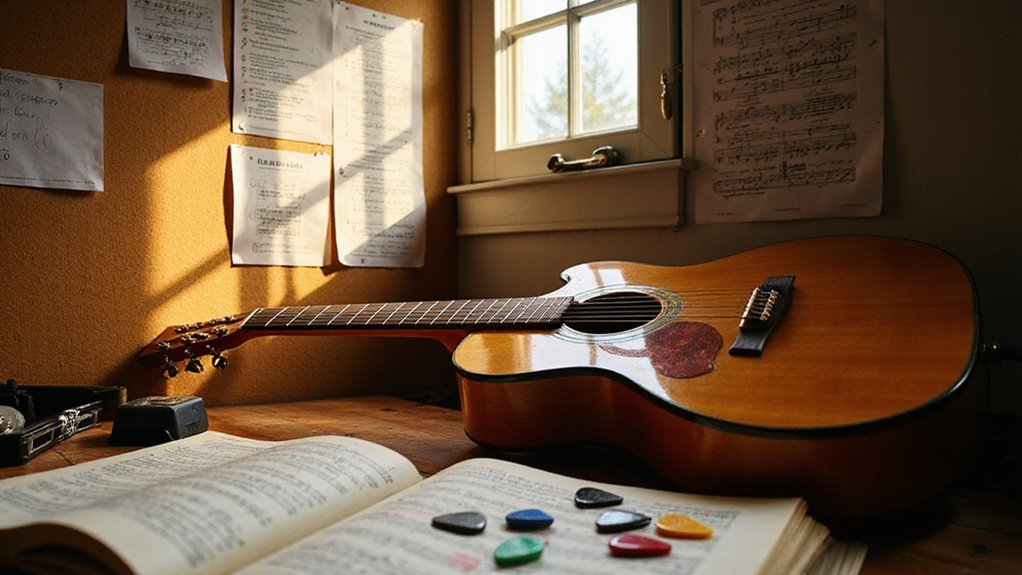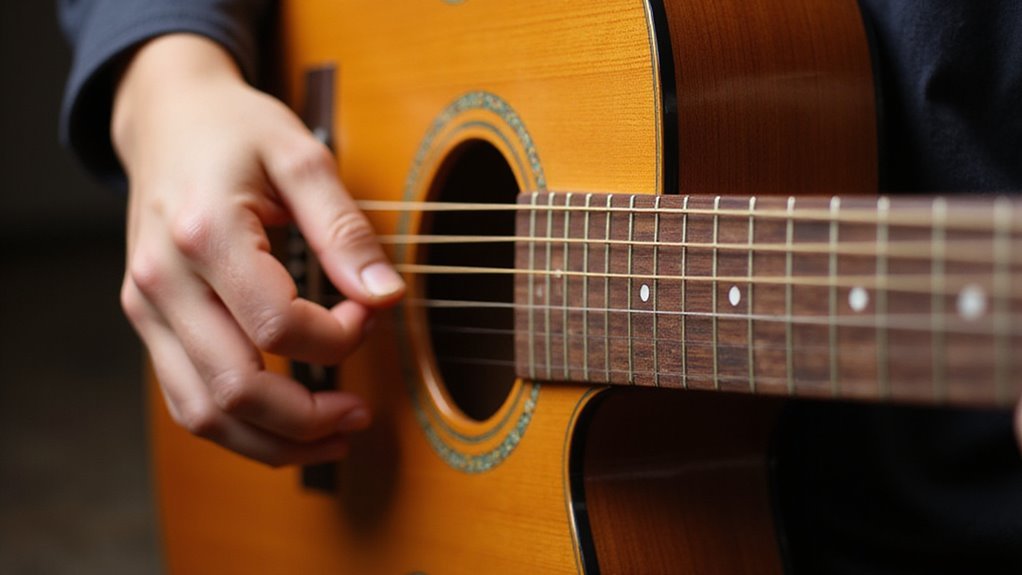Just as Jimi Hendrix once found freedom in six strings, you can release your own musical story through songwriting on guitar. When you’re starting out, don’t overthink the process—grab your instrument, play what feels right, and let your emotions guide you. I’ve found that some of my best ideas come when I’m just messing around without any real plan. Perhaps the greatest songs aren’t constructed but discovered, waiting beneath your fingertips like hidden treasures.
Mastering The Essential Building Blocks: Chords and Scales

The two fundamental building blocks for writing guitar songs are chords and scales.
You’ll find that learning a handful of essential chords—like your majors (A, E, D, G, C) and some minors—creates the foundation for expressing almost any musical idea you might have.
I think scales might seem intimidating at first, but they’re really just roadmaps for your fingers.
Practice them daily, perhaps focusing on major and minor scales to start. They’ll help you craft melodies that flow naturally with your chord progressions.
When these elements become second nature, you’re free to focus on what truly matters—expressing yourself.
Crafting Your Unique Sound Through Chord Progressions

A powerful chord progression can define your song’s entire personality.
Whether you’re building on the classic I-IV-V or experimenting with something more unique, your chord choices establish the emotional foundation of your music.
I think the best approach is trying familiar progressions first, perhaps in different keys, before venturing into uncharted territory.
The Circle of Fifths can be your guide here – it’s helped me understand how chords naturally flow together.
Don’t worry about being too original at first.
Most memorable songs use surprisingly simple progressions, but it’s how you implement them with your strumming patterns and timing that creates something truly yours.
The Rhythmic Element: Strumming Patterns That Elevate Your Songs

Strumming patterns breathe life into even the simplest chord progressions, transforming basic chords into songs with personality and emotion. Whether you’re crafting a gentle ballad or an energetic anthem, your strumming technique might be what sets your music apart.
I think experimenting with different patterns is essential – perhaps switching from steady downstrokes to a more complex down-up pattern can completely change your song’s feel.
Try varying your intensity too. Sometimes the subtle shift from aggressive strumming in your chorus to a gentler approach in verses creates that emotional contrast listeners connect with.
From Riffs to Choruses: Creating Memorable Guitar Hooks
Memorable guitar hooks stand at the heart of countless iconic songs, drawing listeners in from the first note and lingering in their minds long after the music ends. When you’re crafting your own songs, these hooks become your musical signature—perhaps the most essential element that makes your music recognizable.
| Hook Type | Complexity | Emotional Impact | Best Used For |
|---|---|---|---|
| Simple Riffs | Low | Immediate | Verses, Intros |
| Power Chords | Low-Medium | Energetic | Rock Choruses |
| Arpeggiated Patterns | Medium | Contemplative | Atmospheric Parts |
| Lead Melodies | High | Powerful | Song Climaxes |
Your most effective hooks often emerge when you’re just playing around. Trust your instincts—if it catches your attention, it’ll likely catch others’ too.
Marrying Melody and Lyrics: The Art of Songwriting Expression
The perfect marriage between melody and lyrics creates the emotional heart of any guitar song. When you align your musical ideas with meaningful words, you’re crafting something that resonates with listeners on a deeper level.
Start by adapting your melody to fit the natural rhythm of your lyrics – or perhaps reshape your words to complement that perfect tune you’ve created. I think the most powerful songs often emerge when neither element overshadows the other.
Try singing your lyrics while strumming, making adjustments until it feels right. Sometimes imperfection creates character that connects more authentically with your audience.
Experimentation Techniques: Capos, Tunings, and Beyond
Opening creative possibilities often begins with gear experimentation that transforms your guitar’s sonic palette.
Try a capo—this simple tool changes your instrument’s key while letting you use familiar chord shapes, perhaps breathing new life into a stalled composition.
Alternate tunings, I think, might be your biggest revelation. Drop D or open G can spark ideas you’d never discover in standard tuning. It’s like having a completely different instrument under your fingers!
Don’t forget tempo changes and rhythmic variations. Sometimes slowing down a section or adding an unexpected pause creates that magical moment your song needs.
We all get stuck sometimes—experimentation is your way forward.
Frequently Asked Questions
How Do I Overcome Writer’s Block When Composing Guitar Songs?
To overcome writer’s block, try experimenting with new chord progressions, scales, or tunings. Take breaks, listen to inspiring music, improvise freely, or change your environment. Practice daily even when uninspired.
Can I Write Good Songs Without Formal Music Theory Knowledge?
Where there’s a will, there’s a way! You can absolutely write great songs without formal theory. Many legendary songwriters rely on their ears and feelings rather than textbook knowledge. Trust your intuition.
How Long Should It Typically Take to Write a Complete Song?
There’s no standard timeline for songwriting; you’ll find it varies from an hour to months. Trust your creative process—some of your best songs might flow quickly, while others need time to mature properly.
Should I Write Lyrics or Guitar Parts First?
Nearly 50% of songwriters start with music first. You can begin with either lyrics or guitar parts—there’s no right way. Trust your natural creative flow and avoid forcing a process that doesn’t feel authentic.
How Do I Copyright My Original Guitar Songs?
You can copyright your original songs by registering them with the U.S. Copyright Office online, recording demos as proof of ownership, or using the “poor man’s copyright” by mailing yourself sealed recordings.
Conclusion
Writing songs on your guitar isn’t a sprint—it’s more like tending a garden where melodies bloom with patience and care. You’ve got the tools now; let your fingers explore the fretboard without fear. Trust your ear, break a few rules, and don’t overthink it. Your unique voice matters. Sometimes the most powerful songs emerge when you’re just being yourself, imperfections and all.